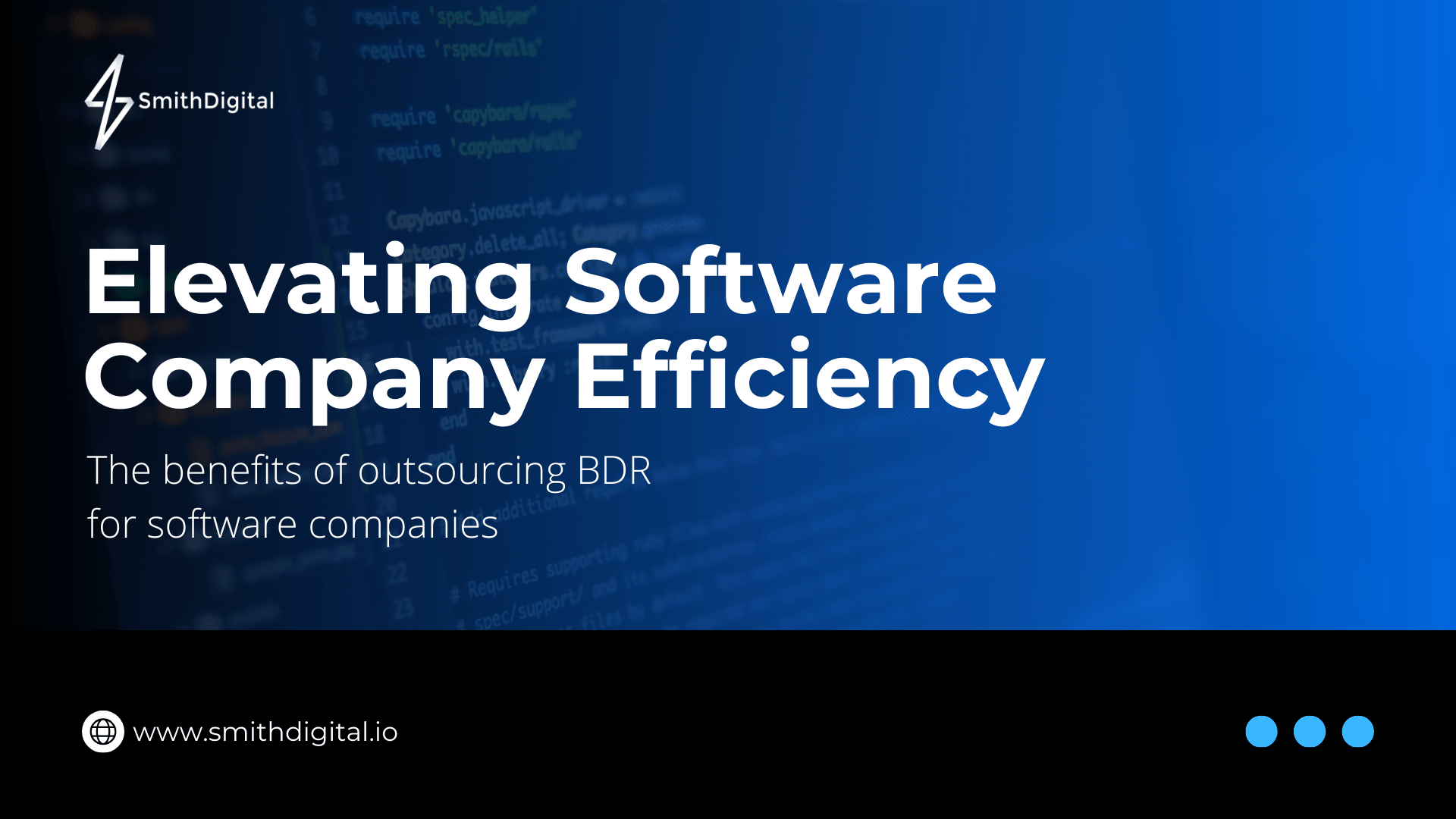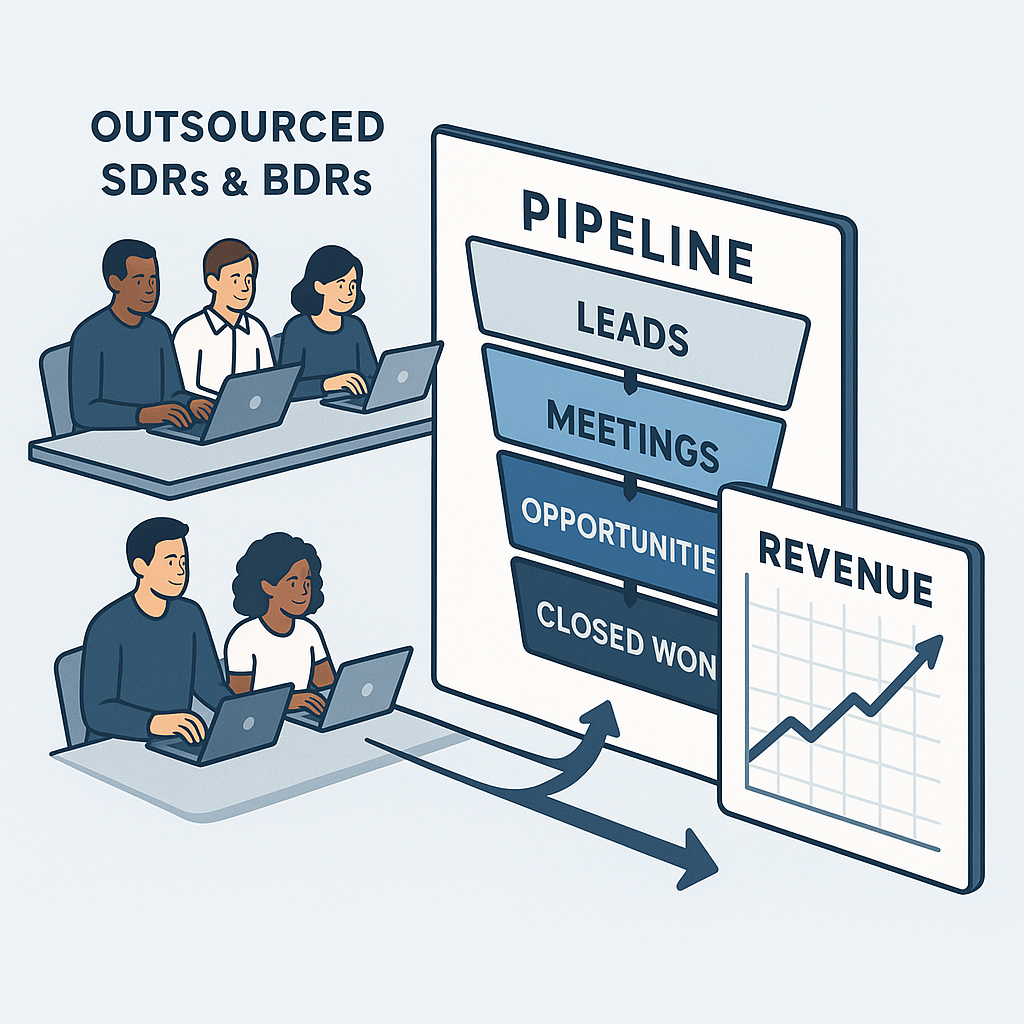Outsourcing BDR Checklist: How to Choose the Right Partner
Outsourcing your BDR team can unlock serious growth—but only if you choose the right partner. Are your reps stuck chasing cold leads while qualified...
%20(23).png?width=302&height=302&name=_SD%20web%20assets%202025%20(500%20x%20500%20px)%20(23).png)
7 min read
Eric Smith
:
Oct 17, 2025 4:00:00 PM
Struggling to build a pipeline without burning time or budget? You’re not alone. For most founders, managing in-house BDRs means high churn, long ramp times, and mounting overhead with little to show for it in the early months.
That’s why, as of 2025, companies that outsource BDR functions are cutting up to 70% in operating costs while scaling outreach faster and leaner than ever.
This guide breaks down why BDR outsourcing is becoming the default move for lean, growth-driven teams and how to do it without killing your brand or wasting budget. For a deeper look at how SDR and BDR outsourcing fits into your overall sales strategy, check out this complete outsourcing guide.
A BDR (Business Development Representative) is responsible for outbound lead generation. Their job: identify prospects, run outreach, qualify leads, and book meetings for closers.
They don’t close deals, but without them, deals don’t start. Whether you build internally or work with an outsourced BDR team, this role is critical to any sales development strategy.
Great BDRs improve pipeline quality, reduce sales friction, and free your sales team to focus on revenue. That’s why more companies are turning to outsourced business development to grow faster without the weight of hiring, onboarding, and managing an internal team.
BDR outsourcing is no longer a fringe strategy. It’s actually becoming the default for companies looking to expand without being dragged down by slow hires, overhead, or unpredictable churn. For many growth-stage startups, outsourcing is the only way to hit pipeline targets fast. Here are the key benefits of outsourcing BDR services.
If you’re evaluating providers, SmithDigital offers outsourced BDR programs built for speed, scalability, and sales alignment. Our team specializes in helping early- to mid-stage companies scale outbound without the overhead of building in-house.
Speed matters. An outsourced BDR team comes trained, tech-enabled, and ready to execute. Instead of spending months building an in-house team, companies can have reps prospecting, qualifying, and booking within weeks. This enables faster pipeline velocity and earlier sales wins.
Hiring in-house means salaries, benefits, tools, and full-time management. Outsourcing your BDR function turns all that into a flat, scalable monthly cost. You also reduce risk—no onboarding delays, no sudden churn, no sunk costs in reps who don’t ramp.
Need to double outbound next quarter? A good outsourcing partner can ramp headcount and outreach without you posting a single job. Whether it’s launching a new business development program or expanding into new verticals, outsourcing provides the agility most internal teams can’t match.
Outsourcing also unlocks access to experienced sales development roles, proven business development strategies, and built-in tools for lead generation and pipeline management. It lets your sales team stay focused on closing while the outsourced team handles top-of-funnel execution.
For companies using BDR outsourcing wisely, the result is more high-quality leads, optimized outreach, and faster time-to-revenue, all without the overhead of building an in-house operation from scratch.
While outsourcing BDRs can unlock growth, it’s not foolproof. If you pick the wrong outsourcing partner or treat it like a hands-off solution, you risk damaging your pipeline instead of building it. Here are the biggest pitfalls:
1. Brand Voice Dilution
An outsourced team may not fully grasp your tone, positioning, or messaging. Without tight alignment, outreach can feel cold, generic, or off-brand—especially in high-stakes sales development efforts.
2. Inconsistent Quality
Some providers staff junior reps with little training or industry context. Poor list building, spammy messaging, and sloppy execution can undermine trust and derail your sales pipeline.
3. Communication Gaps
When outsourced BDRs operate in a silo, it creates friction with your internal sales team. Missed handoffs, redundant outreach, or a lack of feedback loops kill momentum and lead quality.
4. Loss of Control
You don’t manage their hiring, training, or workflows. That means less visibility into performance and fewer levers to pull when things break. For some orgs, the reduced level of control outweighs the upside.
5. Misaligned Goals
Without shared KPIs, even a good BDR partner can drift off course. Make sure your business goals and success metrics are baked into the program from day one.
The core BDR role doesn’t change, but how it’s executed can vary dramatically depending on whether your team is internal or outsourced. Each model has trade-offs across speed, quality, control, and transparency.
| Activity | In-House Team | Outsourced BDRs |
|---|---|---|
| Prospecting | Custom, but slower | Fast, often templated |
| Email Sequences | Personalized if managed well | May rely on scalable templates |
| Cold Calling | Consistent with strong coaching | Quality varies by agency |
| CRM Updates | Fully visible, tightly managed | Requires integration and oversight |
| Feedback Loops | Daily syncs and tighter alignment | Weekly check-ins, less real-time |
Outsourced teams win on speed, cost efficiencies, and scalable output. In-house teams win on brand control, visibility, and deeper integration with your broader sales development strategy.
Most business development outsourcing agencies offer modular services that can flex with your sales team’s size, tech stack, and go-to-market goals. Choosing the right model depends on your internal gaps and desired speed to results:
Agencies handle everything—ICP development, list building, multichannel outreach, and appointment setting. Best for companies without a dedicated sales development team or business development roles in-house. It's a fast way to launch without hiring or training.
You supply the leads or target list, and the outsourced BDRs focus purely on execution. It’s a lean option for teams with strong sales strategies in place but no capacity for cold outreach. Expect faster ramp and lower costs, but less strategy support.
Top providers use a mix of cold calls, emails, LinkedIn, and SMS to boost engagement. This model is essential for companies looking to optimize outbound at scale and connect with prospects across multiple channels in one cohesive BDR program.
For companies targeting enterprise or strategic accounts, some agencies offer ABM-style development outsourcing. These services use deep research and persona-based messaging to deliver high-quality leads from your most valuable segments.
Providers like SmithDigital offer flexible engagement models, from full-cycle prospecting to specialized appointment setting, making it easier to match services to your team structure and growth goals.
Working with the right outsourcing partner means choosing the mix that fits your current business development efforts, growth stage, and internal capacity. The best agencies operate as an extension of your team, not just a vendor.
Outsourcing the BDR function can accelerate growth, but only if you set the right guardrails. Before choosing a provider, lock down the fundamentals:
1. Define Success Metrics
Set clear KPIs such as SQLs, conversion rates, and outreach volume. Don’t just aim for meetings. Define what counts as a win, so your outsourced BDR sales team can be held accountable.
2. Budget Realistically
Top-tier sales development outsourcing isn’t cheap. Expect to invest $8K–$12K/month and see results after 6–8 weeks. If your budget is tighter, reconsider whether now is the right time.
3. Check Tech Compatibility
Your outsourcing partner should integrate directly into your CRM and sales tools. If they can’t plug into your sales process, you’ll lose visibility and data accuracy.
4. Match Language and Region
If your buyers are in North America, don’t outsource to reps who can’t align culturally or linguistically. Time zones, tone, and clarity impact lead generation services more than you think.
5. Know Your Business Needs
Different agencies serve different use cases. Define whether you need appointment setting, full-funnel support, or ABM. Choose the provider that fits your stage, not just your budget.
Want a full breakdown of when to outsource, what to outsource, and how to align with internal sales goals? Read the full BDR outsourcing strategy guide for a tactical roadmap.
Choosing a BDR agency isn’t a checkbox. Rather, it’s a high-leverage decision. The right partner can accelerate the pipeline and align with your business development goals. The wrong one can stall progress and damage your brand early in the sales process.
Don’t settle for generic testimonials. Ask for detailed metrics such as meetings booked, SQLs generated, and conversion rates from outreach to pipeline. If an agency can’t back up its claims with data and relevant case studies, keep looking. SmithDigital is known for building performance-driven outsourced BDR programs that align with real revenue goals, not vanity metrics.
Relevance matters. A BDR partner with experience in your market will understand your buyer, language, and positioning from day one. Tech and SaaS companies, in particular, need teams fluent in product-led messaging and high-consideration sales cycles. Look for an agency with deep domain expertise, not one learning your industry on your dime.
You should know exactly what your outsourced team is doing daily. The right partner will provide CRM access, weekly updates, and activity-level transparency that maps cleanly to your sales process. Without that, you’re just buying activity without accountability.
Never skip this step. Speak to active clients, not just past ones. Ask how the agency handles onboarding, lead quality, pivots, and communication. The best agencies will encourage this. They know their clients will vouch for them. This step protects you from misaligned expectations and gives you insight into how the agency performs beyond the sales pitch.
Outsourcing your BDR function isn’t “set it and forget it.” To deliver results and fuel real business growth, your agency should function as an extension of your internal sales team. That means structure, alignment, and feedback from day one:
Your internal team and your outsourced BDR sales team must operate on the same page. Hold weekly syncs between your sales leader and the agency lead to review performance metrics, lead quality, and conversion blockers. This is where outsourcing can help surface issues early and keep your sales process running clean.
A great BDR partner is only as strong as the information you give them. Share ICP docs, product walk-throughs, objection handling, and case studies. The more context they have, the better they’ll execute your sales development strategy and act as true business development roles in your growth engine.
Ask your AEs for honest feedback on lead quality. Then feed those insights back into the outreach strategy monthly. This tight development process helps refine messaging, improve targeting, and keep your business development team aligned with outcomes—not just activity.
If you're serious about scaling your pipeline without drowning in hiring, onboarding, and overhead, outsourcing your BDR function isn’t a gamble; it’s a strategic edge. It lets your sales team focus on closing while a dedicated outsourced business development partner fills the funnel with high-quality leads.
The companies winning in 2025 are the ones who optimize for speed, efficiency, and execution. With the right partner, outsourcing BDRs doesn't dilute control—it multiplies your impact.
Book a pilot call with SmithDigital and see how we can accelerate your pipeline, fast.

Outsourcing your BDR team can unlock serious growth—but only if you choose the right partner. Are your reps stuck chasing cold leads while qualified...

Software companies are currently facing heightened competition and a greater need to fill their sales pipelines with qualified leads. Outsourcing BDR...

Building a consistent pipeline has never been more complex. Marketing and sales leaders are under pressure to fill funnels, drive revenue, and...